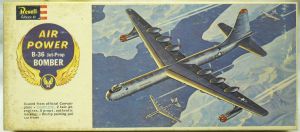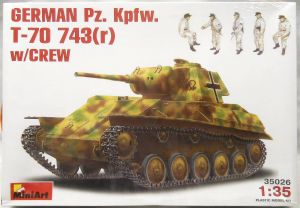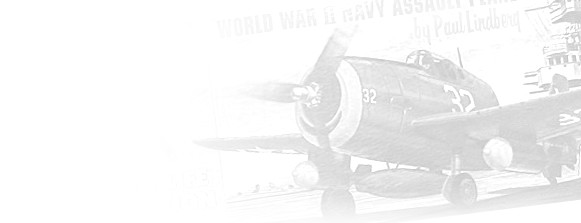Monogram De Havilland Mosquito - N.F.II / Mk.IV / F.B.VI / II Night Intruder - Four Star Issue, 1/48, PA129-200
Plastic Model Kit, Box Condition: Good
$42
First issue 'Four Star' kit dated 1965. Very finely molded and detailed for that time and contains parts to build any one of four versions: NF II Night Fighter, Mk IB Bomber, Mk VI Fighter Bomber and MkII Night Intruder. There is no assembly but NOTE: one propeller and two seats are neatly painted. It has been inventoried complete with all parts and includes decals and instructions.
Amodel TWO KASKR-2 Autogyro, 1/72, 7279
Plastic Model Kit, Box Condition: VG+

$20
SALE!! Includes both kits in the one box shown. They have never been started and both are still in the factory sealed bag. Includes instructions. Please note that this aircraft had no markings, so Amodel did not provide decals. N.I. Kamov and N.K. Skrzhinsky built KASKR-1, the first Soviet autogyro, which made it's first flight on September 25, 1929. Soon afterwards they built an improved model, the KASKR-2 in 1930. Both designs were successful and a total of 79 flights were made by both aircraft between 1929 and 1931.
Eastern Express Heavy Tank KV-9, 1/35, 35088
Plastic Model Kit, Box Condition: Sealed VG

$28
Still factory sealed.
Revell Alpha Jet / Matchbox A-4M/N Skyhawk / KP Mig-21MF Fishbed / Sukhio Su-25K Desert Storm, 1/72, 4105
Plastic Model Kit, Box Condition: VG to Exc

$22
SALE!! Includes all four kits in the original boxes. The Alpha, Mig and Sukhoi are all never started and inventoried complete with all parts and includes decals and instructions. The A-4M/N Skyhawk is as following: NOTE: this kit has minor, 'professional' quality subassembly as follows: one bulkhead to the rear of one fuselage half. There is no other assembly. Inventoried 100% complete and includes decals and instructions.
Revell TWO TF-104G Starfighter / TWO Hawker Hunter FGA.9 / TWO Mig-29 Fulcrum, 1/144, 04008
Plastic Model Kit, Box Condition: VG

$26
SALE!! Includes SIX kits in the three boxes shown (there are two kits in each box). In each box, the kits are never started. Kit #1 is still factory sealed and includes decals and instructions. Kit #2 is never started and inventoried complete with all parts and includes decals and instructions.
Amodel Kamov Ka-126 - Aeroflot, 1/72, 7272
Plastic Model Kit, Box Condition: VG

$18
Civil version of the second helicopter in this well-known and successful family. Features all fine recessed surface detail, very good cockpit, cabin with interior and bulkheads and more. Includes extensive decals for the box art helicopter shown. Never started and inventoried complete with all parts and includes decals and instructions.
Sure Flite All Foam Floats With Fibreglassed Bottom And Spray Rails - 28 Inch Long For R/C Aircraft
Other Materials, Box Condition: Good

$36
This box contains a set of 28" long injection molded foam floats. The Bottom and Spray Rails have been fiberglassed; the total weight per pair which includes spruce spars and fly plywood attachment tabs is 8 ounces. Capacity is up to 5.5 pounds. The kit has never been started. The small parts are still in the factory sealed bag; the larger parts that were never sealed have been inventoried complete and includes all paperwork. NOTE: this kit came in a very sturdy and thick cardboard box. It will ship in that box wrapped in thick brown paper. If you wish for it to be placed inside another box, let me know in the 'comments' section of checkout but be aware that additional shipping charges will apply and an invoice will emailed to you for that.
Special Hobby TWO Bell X-1A/D - Second Generation, 1/72, SH72160
Plastic Model Kit, Box Condition: VG

$34
SALE!! Includes two kits in the one box shown. Both models are never started and inventoried 100% complete with all parts, decals and instructions present. This well detailed model features main injection molded parts with all recessed panel lines, fine high-definition resin and photoetched metal details, very well detailed cockpit and more. Includes paint guide and decals.
Aoshima Mitsubishi Ki-67 Hiryu Peggy Bombers - Two Kits, 1/144, 4
Plastic Model Kit, Box Condition: Good+

$24
Contains two complete Peggy bombers. Very nicely detailed and features very fine raised panel lines, finely molded parts, clear windshield, side blisters, turrets & observation windows, rotating wheels & propellers and more. Includes decals for two aircraft. The model has not been started. Inventoried 100% complete with all parts, decals and instructions.
Guillows Arrow - 28 inch Wingspan - Rubber or Gas Powered Freeflight Aircraft, 702
Wood Model Kit, Box Condition: Good
$24
Early issue hardbox from 1967. Quality stick-and-tissue model designed for long distance/high endurance rubber-powered or .020 Pee-Wee gas powered flights. Features quality die-cut balsa parts, stripwood and spars, light plastic vacuform spinner, exhaust & pilot bust, plastic prop and thrust button, contest rubber, fully formed wheels, balancing clay, metal gear struts and prop shaft, clear windshield material, decals, two colors of covering tissue, full size plans, detailed instructions on flying and more. The model has not been started and inventoried 100% complete. Guillow's founder, Paul K. Guillow, was a WWI naval aviator. In 1926 he began producing wooden model airplane kits. His 'Shelf Models' were some of the earlier non-flying models in production. Guillow's grew during the model boom of the 1930s, and when the Depression hit the hardest, Guillow's responded with lower prices and became one of the low price leaders, frequently advertising in Model Airplane News and other leading publications. During the war, like most manufacturers, Guillow's was forced to alternative materials such as cardboard and pine. Guillow's survived the post WWII slump by creating many inexpensive profile flying rubber powered aircraft and gliders in the 1950s (along with North Pacific) which became famous - some are still available today. The stick and tissue lines have been updated with laser cut parts and are still in production as of 2009.
Hasegawa TWO Morane Saulnier MS-406 Finnish Air Force, 1/72, AP104
Plastic Model Kit, Box Condition: Exc+
$35
SALE!! Includes both kits in the one box shown. They have never been started and both have been inventoried complete with all parts, decals and instructions included. 1994 special issue with Finnish markings features all fine recessed panel lines, very good cockpit and more. With decals and paint guide for two Polish aircraft. Never started and inventoried complete with all parts and includes decals and instructions.
MPM Mitsubishi Ki-21 Sally - With Decals For 9 Different Aircraft, 1/72, 72511
Plastic Model Kit, Box Condition: VG+

$44
Rare. This excellent model kit features all recessed panel lines, cleanly molded plastic pieces, many high-definition resin parts including a superb full cockpit and interior parts, injection molded clear parts and more. Includes two sheets of decals and a paint guide for 9 different aircraft. Never started. The parts are still in the internal factory sealed bags and includes decals and instructions.
Revell SMS Emden Light Cruiser - WWI Commerce Raider - With Gold Medal Models Emden PE Detail Set, 1/350, 05039
Plastic Model Kit, Box Condition: Good-

$95
Includes Gold Medal Models SMS Emden Brass PE Detail Set specifically designed for this kit. It features precision railings, accommodation ladders and davits, ratlines, boat safety lines, boat oars, compass tower assembly, bridge wing supports, director platform assembly, perforated gusset (supports) for raised platforms, anchor chains, chain stopper cable, canvas covered bridge railing, included ladders, vertical ladders, boat rudders, ships wheelboat boom ladders and more. In mint condition with instructions. The actual kit is very well detailed from brand-new, state-of-the-art molds. The story of Emden's Indian Ocean raiding career in WWI is legendary and it's wonderful to finally have an quality model of this historic ship. Never started. The parts are still in the internal factory sealed bags and includes decals and instructions. NOTE: the instructions are photocopies
Revell Mil Mi-8 Hip SAR, 1/72, 4423
Plastic Model Kit, Box Condition: Good

$20
This is a very well detailed and molded model that features very good cockpit, complete cabin, optional position cabin doors, optional parts and more. Never started and the parts are still in the internal factory sealed bags and includes decals and instructions.
SIG Bristol Scout ARF - 30.78 Inch Wingspan R/C Aircraft, SIGRC94ARF
Other Materials, Box Condition: Exc

$58
This is an almost-ready-to-fly foam aircraft with fast, easy assembly with a fully illustrated manual. Never started. Everything inside is exactly as it left the factory. The parts that were factory sealed are still sealed. The parts were never sealed and have been inventoried complete. Includes all paperwork.
Revell B-36 Jet-Prop Bomber Air Power Issue, 1/184, H139-130
Plastic Model Kit, Box Condition: Good-

$44
Hardbox 'Air Power' series hardbox issue with a copyright date of 1961 and classic box art. This kit is from the original molds as the Pre-S kit and makes an ideal builder. The kit has never been started. It has been inventoried complete with all parts and includes decals and instructions.
Hobby Boss TA-7C Corsair II - Two Seat Trainer, 1/72, 87209
Plastic Model Kit, Box Condition: VG

$22
Very nicely detailed model from all new molds. Features 190 pieces, all fine recessed panel lines, very good cockpit, detailed gear wells and more. NOTE: this kit has minor, 'professional' quality subassembly as follows: cockpit tub assembled; turbine fan to back of exhaust cone; two supports to main gear bay well. There is no other assembly. Inventoried 100% complete and includes decals and instructions.
Revell F-5E Tiger II / Ace Mig-23 Flogger / DML F-15C Eagle / Dragon TWO USMC AV-8B / Trumpeter TWO Morser Karl-Gerat 040 and Plattformwagen with Pazner III Ausf F And Railway Gondola, 1/144, 04018
Plastic Model Kit, Box Condition: Exc+ to Sealed NM

$26
SALE!! Includes all 8 1/144 scale kits in the 6 boxes shown. The F-5E and (2) USMC AV-8B are all still factory sealed. The F-15C and Panzer Railway kits are never started and the parts are still in the internal factory sealed bags and includes decals and instructions. The (2) Morser Karl-Gerats are never started and inventoried complete with all parts and includes decals and instructions.
Amodel TWO KASKR-1 Autogyro, 1/72, 7265
Plastic Model Kit, Box Condition: VG

$24
SALE!! Includes both kits in the one box shown. They have never been started and both are still in the factory sealed bag. Includes (1) decal and (2) instructions. NOTE: missing one decal. N.I. Kamov and N.K. Skrzhinsky built this first Soviet autogyro which made it's first flight on September 25, 1929. Soon afterwards they built an improved model, the KASKR-2 in 1930. Both designs were successful and a total of 79 flights were made by both aircraft between 1929 and 1931.
MiniArt German Pz. Kpfw. T-70 743(r) With Crew - (ex Soviet T-70 Light Tank), 1/35, 35226
Plastic Model Kit, Box Condition: Sealed Exc

$24
Still factory sealed. From 2004 and all new modern molds which are very well detailed.
